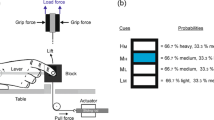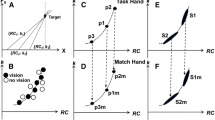Abstract.
We used a perturbation technique to quantify the contribution of visual size cues to the programming of target force when lifting an object. Our results indicate that the nervous system attaches a reasonable weight to visual size cues when programming the target grip force for a novel object. In a subsequent lift of the same object, however, the confidence attached to the visual size cue fell dramatically. It is not clear whether the decrease in the use of size information was accelerated by the presence of a cue conflict or whether the fall represents the normal shift towards the use of a memory-based representation for programming grip force. In a second experiment, we used the "size-weight illusion" to explore the relationship between the verbal report of an object's weight and the programming of the grip and load force. We found that erroneous motor programming (as indexed by a number of measures) was neither necessary nor sufficient for the size-weight illusion to occur. These findings call for a re-evaluation of a previous explanation for the size-weight illusion. We suggest that the illusion arises because the cognitive system attempts to rationalise the fact that objects of apparently equal density but different size feel as if they have the same weight.
Similar content being viewed by others
Author information
Authors and Affiliations
Additional information
Electronic Publication
Rights and permissions
About this article
Cite this article
Mon-Williams, M., Murray, A. The size of the visual size cue used for programming manipulative forces during precision grip. Exp Brain Res 135, 405–410 (2000). https://doi.org/10.1007/s002210000538
Received:
Accepted:
Issue Date:
DOI: https://doi.org/10.1007/s002210000538




